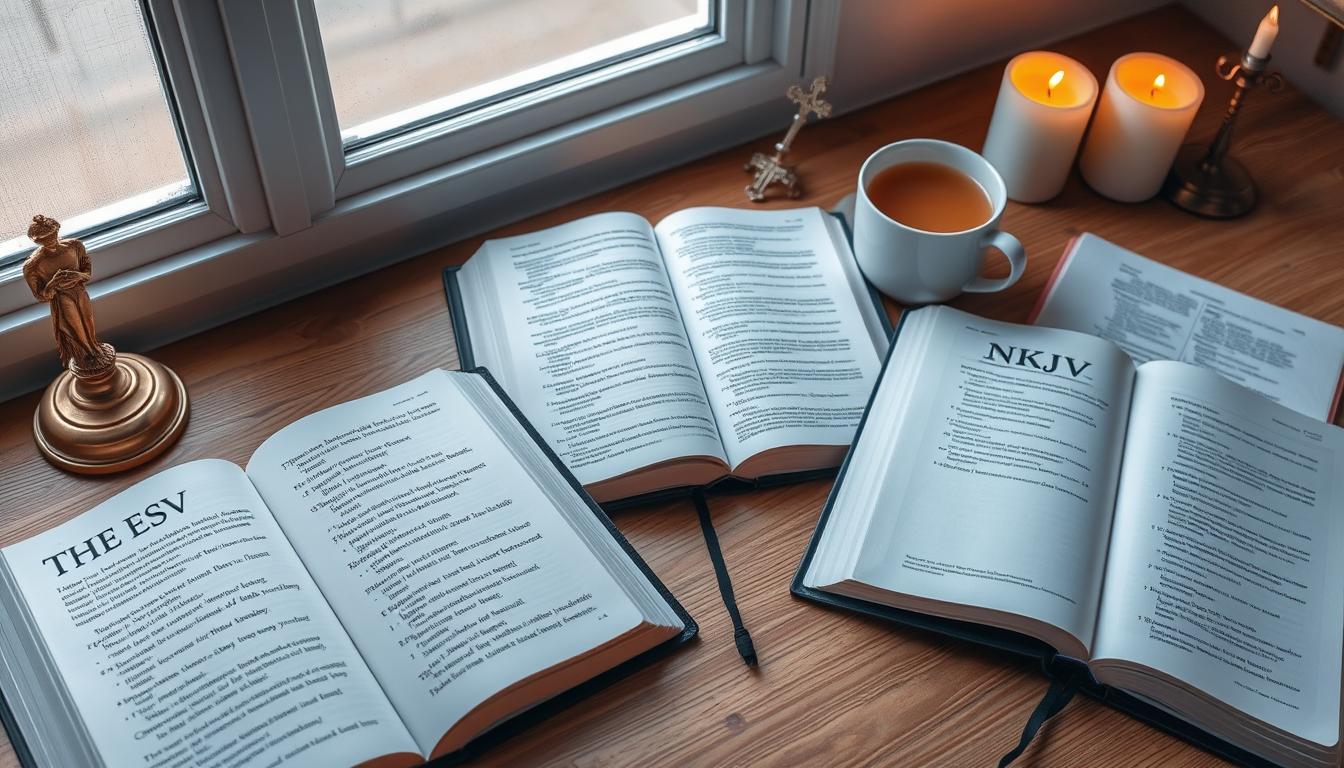Which Bible translation is the most accurate and easy to read for today’s Christians? The debate over the English Bible versions like the English Standard Version (ESV), New International Version (NIV), and New King James Version (NKJV) is ongoing. These versions have different translation methods, sources, and strengths and weaknesses. Knowing these differences helps Christians pick the best Bible for their needs, whether for daily reading, study, or understanding cultural and historical context.
Key Takeaways
- The ESV, NIV, and NKJV have different translation styles, from word-for-word to thought-for-thought.
- The ESV and NKJV aim for a literal translation, while the NIV focuses on meaning.
- The sources for these translations vary, with the ESV and NKJV using traditional texts like the Textus Receptus.
- Readability and literary quality differ, with the NKJV being easier for some readers than the ESV and NIV.
- Choosing the right Bible translation depends on the reader’s knowledge and the purpose, whether for devotions or study.
Introduction to Bible Translations
The Bible was first written in ancient languages like Hebrew, Aramaic, and Greek. As it spread worldwide, translations into languages like English became crucial. Today, over 450 English Bible translations exist, each with its own way of making the original texts understandable in modern language.
Why Are There Different Translations?
There are many reasons for the many Bible translations. New discoveries and better understanding of ancient languages led to the need for more translations. Translators also aimed to meet different reading levels and styles, while keeping the original meaning.
History of Bible Translation
The history of Bible translation is both rich and complex. The King James Version (KJV), finished in 1611, was a major achievement by 47 scholars. It remains a favorite and influential version. The New International Version (NIV), published in 1978, is now the top-selling Bible. It’s known for balancing literal and dynamic translation.
The English Standard Version (ESV) and the New King James Version (NKJV) are also well-liked. Each has its own features and audience.

“The Bible is the Word of God, and when I see it I seem to hear a voice saying: ‘I am the book that teaches men the way to heaven. All other books which men write teach us to know ourselves and the world in which we live; but the Bible teaches us how to know God and our duty to him.'” – Queen Victoria
Types of Bible Translations
Bible translations fall into two main types: formal equivalence (word-for-word) and dynamic/functional equivalence (thought-for-thought). Formal equivalence translations aim to mirror the original language closely. They keep the same grammar, vocabulary, and sentence structure. On the other hand, dynamic/functional equivalence translations focus on the meaning and natural flow in the target language. Knowing these philosophies helps us see the good and bad of different Bible versions.
Formal Equivalence (Word-for-Word)
Formal equivalence translations, or “word-for-word” or “literal” translations, aim for a direct match between the original and target languages. They try to keep the exact wording and sentence structure, even if it’s not natural in the target language. This approach helps readers study the text deeply and understand the biblical languages better. Examples include the English Standard Version (ESV) and the New American Standard Bible (NASB).
Dynamic/Functional Equivalence (Thought-for-Thought)
Dynamic/functional equivalence translations, or “thought-for-thought” or “meaning-based” translations, focus on the meaning and impact of the original text. They aim to express ideas naturally and easily, even if it means changing the source text’s words. The goal is to make the translation smooth and convey the message well, not just follow the source word-for-word. Examples include the New International Version (NIV) and the New Living Translation (NLT).

Knowing the difference between these two philosophies helps readers pick a Bible version that fits their needs. Whether you prefer a literal or a more dynamic and readable translation, there’s a version for you.
ESV vs NIV vs NKJV: Distinctive Approaches
The English Standard Version (ESV), New International Version (NIV), and New King James Version (NKJV) each have their own way of translating the Bible. The ESV came out in 2001 and is based on the Revised Standard Version (RSV) with some changes. It covers about 60,000 words. It aims for a mix of being literal and easy to read, making it clear and beautiful.
The NIV was first published in 1978. It focuses on being easy to understand and uses modern language. It tries to balance being accurate and clear in its translation. The NIV has been updated a few times, with the big change in 2011 to keep up with new research and feedback.
The NKJV was released in 1982, based on the King James Version (KJV). It keeps the KJV’s style but updates the language. It uses more formal language than the NIV, sticking to traditional words. The NKJV is known for being very accurate in its translation, aiming for word-for-word matching. It’s widely accepted for study, worship, and school use.
In short, the ESV balances literal accuracy with easy reading, the NIV focuses on being clear and readable, and the NKJV sticks to the KJV’s style while being very accurate.

| Translation Approach | ESV | NIV | NKJV |
|---|---|---|---|
| Translation Philosophy | Essentially literal, balanced approach | Dynamic equivalence, balances accuracy and clarity | Formal equivalence, emphasizes word-for-word accuracy |
| Publication Date | 2001 | 1978, with revisions | 1982 |
| Language Style | Readable, literary excellence | Clear, contemporary | Traditional, classic literary style |
| Manuscript Basis | 92% RSV, 8% modified | Variety of manuscripts | Textus Receptus for New Testament |
| Denominational Acceptance | Wide acceptance | Historically widely used | Popular among conservative denominations |
The ESV, NIV, and NKJV each have their own unique ways of translating the Bible. They meet different needs and preferences of readers.
Manuscript Basis of Each Translation
The English Standard Version (ESV) and New International Version (NIV) are top Bible translations. Each has its own manuscript basis. Knowing the texts they use is key to judging their trustworthiness.
ESV Manuscript Basis
The ESV mainly uses the Masoretic Text for the Old Testament. But it also looks at other ancient texts like the Dead Sea Scrolls and Septuagint. This way, the ESV stays true to the original language and adds more depth.
NIV Manuscript Basis
The NIV also starts with the Masoretic Text for the Old Testament. But it also checks other early texts when the Masoretic Text is unclear. This includes the Dead Sea Scrolls and Septuagint, making the NIV’s translation more comprehensive.
The NIV’s New Testament is based on the Nestle-Aland/United Bible Societies’ Greek New Testament. This is the top critical text for the Greek New Testament. It makes sure the NIV’s New Testament is based on the best scholarly Greek texts.

In short, both ESV and NIV use a variety of ancient texts. This includes the Masoretic Text, Dead Sea Scrolls, Septuagint, and Vulgate. This method ensures their translations are accurate and easy for today’s readers to understand.
Significant Differences in 1 John 5:1-12
Looking at 1 John 5:1-12 in the English Standard Version (ESV), New International Version (NIV), and New King James Version (NKJV) shows some big differences. For instance, the first verse says “is born of God” in the NIV and NKJV, but “has been born of God” in the ESV. The New Living Translation (NLT) says “has become a child of God.” It’s clear that loving God and following His commands are key. This shows how much we care for God and His children.
In Verse 7 of the NKJV, there’s extra text about the Trinity that’s not in the other versions. The KJV talks about the Father, the Word, and the Holy Ghost being the three witnesses in heaven. It also mentions the spirit, water, and blood on earth as witnesses. These differences show how different views and sources can change how we see certain Bible passages.
| Verse | ESV | NIV | NKJV |
|---|---|---|---|
| 1 John 5:1 | has been born of God | is born of God | is born of God |
| 1 John 5:7 | For there are three that testify: | For there are three that testify: | For there are three that bear witness in heaven: the Father, the Word, and the Holy Spirit; and these three are one. |

These translation differences show different views and changes in the text, affecting how we understand 1 John 5. The NIV, for example, talks about the Spirit of God, water, and blood as witnesses. The ASV, NASB, and ESV don’t include the heaven-and-earth phrases. They say the three witnesses are the Spirit, water, and blood.
ESV vs NIV vs NKJV: Comparing Popular Bible Versions
The English Standard Version (ESV), New International Version (NIV), and New King James Version (NKJV) are top choices for Bible readers. Each version has its own way of translating the Bible, affecting how we understand it.
The NIV is loved by many, with over 450 million copies sold. It’s great for personal study and group discussions. The ESV is favored by evangelicals for its accuracy to the original texts. The NKJV keeps the King James Version’s style but is more modern.
These translations differ in how they approach the Bible’s text. The KJV and NKJV use the Majority Text. But the NIV, NASB, NET, HCSB, and ESV rely on the Critical Text. This choice affects how certain words and ideas are translated.
For example, James 2:14 is translated differently. The NIV, NASB, NET, and ESV add words that question faith. But the KJV and NKJV don’t. In 1 Corinthians 5:11, some versions use phrases like “any so-called brother” or “anyone who calls himself a Christian.”
Choosing a Bible version is a personal decision. It depends on what you value most: easy reading, theological focus, or specific needs. Knowing the differences between versions can enrich our understanding of the Bible.
Strengths and Weaknesses of Each Translation
ESV Strengths and Weaknesses
The English Standard Version (ESV) is known for its balance between being formal and easy to read. It’s designed for a 7th grade reading level, making it accessible to many. At the same time, it stays true to the original texts. This makes it appealing to those who want a literal translation.
But, the ESV can be tough for some to read, especially if they’re not used to traditional language. It might take more effort to understand, which can make it less friendly for casual readers.
NIV Strengths and Weaknesses
The New International Version (NIV) is very popular and widely read. It uses a dynamic approach to make the Bible’s message clear and easy to understand. This makes it great for a wide range of readers.
However, the NIV’s approach might lose some of the original text’s precision. It has also faced criticism for its gender-inclusive language, with some saying it goes too far.
| Translation | Strengths | Weaknesses |
|---|---|---|
| ESV |
|
|
| NIV |
|
|
“Each Bible translation has its own unique strengths and weaknesses, and identifying the pros and cons of each version can help readers choose the translation that best suits their needs and reading level.”
In summary, the ESV and NIV offer different approaches to Bible translation. The ESV focuses on accuracy, while the NIV aims for readability. The right choice depends on the reader’s preferences and needs. Knowing the strengths and weaknesses of each version helps readers pick the best one for their study goals.
Readability and Literary Quality
The way a Bible is translated affects how easy it is to read and understand. Some translations, like the English Standard Version (ESV), are more challenging to read but are highly valued for their quality. On the other hand, the New International Version (NIV) is easier to read, making it more accessible to many.
Things like sentence length, word choice, and keeping the original language’s style are key. For example, the New King James Version (NKJV) brings out the Bible’s poetic beauty. The New Living Translation (NLT) makes it simpler for today’s readers, aiming for a 6th-grade level.
Translations like the Holman Christian Standard Bible (HCSB) and the International Standard Version (ISV) are easier to read, at 8th and 4th grade levels. The Good News Bible (GNB), Good News Translation (GNT), and Today’s English Version (TEV) are great for those learning English, with levels between 5th and 6th grade.
Choosing the right Bible translation depends on who you’re reading it for. If you want a deeper, more challenging read, formal equivalence might be best. But if you prefer something straightforward, dynamic equivalence or paraphrase versions could be better.
In the end, how well a Bible is written affects its usefulness for different people. Knowing what each translation offers helps you pick the one that fits your reading style and study goals.
Translation Philosophy and Accuracy
The way a Bible is translated greatly affects its translation accuracy and meaning. There are two main approaches: word-for-word and thought-for-thought. Word-for-word tries to keep the original words and grammar. Thought-for-thought focuses on the meaning and intent behind the words.
Knowing these differences helps us choose the right Bible version. It’s important for personal study, teaching, or understanding the Bible.
Word-for-Word vs. Thought-for-Thought
The debate on translation philosophy centers on finding the right balance. Some translators prefer to stick closely to the original words. Others aim to convey the meaning in a way that’s easy to understand.
For example, the English Standard Version (ESV) uses the word “law” in Romans 74 times. In contrast, the New International Version (NIV) and New King James Version (NKJV) use it less often. This shows how different approaches can change the way we interpret the Bible.
Many scholars and translators have weighed in on this debate over the years. From word-for-word to thought-for-thought, each has brought their own perspective. Eugene Nida’s work on functional equivalence has been a key moment in this ongoing discussion.
Choosing between word-for-word and thought-for-thought depends on what matters most to you. Do you value exactness or clarity? Different versions cater to different readers’ needs.
Understanding these differences is key. It helps us pick the best Bible for our personal study, teaching, or biblical interpretation.
Choosing the Right Bible Translation
Choosing the right Bible translation depends on how you plan to use it. For daily devotions or as a new believer, the New International Version (NIV) or New Living Translation (NLT) might be best. These translations are easy to read and make the Bible’s message clear in today’s language.
For deeper study, formal equivalence versions like the English Standard Version (ESV) or New King James Version (NKJV) are better. They aim to keep the original words and meanings, offering a closer look at the Bible’s roots.
The best translation is the one that helps you understand and connect with God’s Word. The Amplified Bible is also great for deeper study. It adds extra context and clarity with alternative words and definitions.
For Daily Devotions
- NIV – Accessible and engaging translation with a focus on dynamic equivalence
- NLT – One of the easiest Bible translations to read, with a thought-for-thought approach
For In-Depth Study
- ESV – Maintains a word-for-word accuracy while providing smooth readability
- NKJV – An updated version of the KJV, offering a balance between literal translation and modern English
- NASB – Considered the most literal word-for-word translation, prized for its accuracy
“The best translation is the one that helps you engage with Scripture and grow in your understanding of God’s Word.”
When picking a Bible translation, think about what you need. Whether you want something easy to read or precise to the original languages, there’s a translation for you.
| Translation | Approach | Strengths |
|---|---|---|
| NIV | Dynamic Equivalence | Accessible, engaging |
| ESV | Formal Equivalence | Accurate, readable |
| NKJV | Formal Equivalence | Balanced, modern English |
| NASB | Formal Equivalence | Highly literal, accurate |
| Amplified | Formal Equivalence | Provides context and nuance |
Cultural and Historical Context
It’s key to know the cultural and historical setting of the Bible for correct interpretation and translation. Translations that offer insights into the original culture and history are very helpful. They help readers grasp the deeper meaning of the text, not just the words.
The King James Version (KJV) was written in the 17th century. It shows the language and culture of that time. Modern translations like the New International Version (NIV) and the English Standard Version (ESV) aim to be clear for today’s readers. Knowing the context helps readers understand the authors’ original ideas better.
The political, social, and religious settings of ancient times greatly affect how we interpret the Bible. For instance, the idea of honor and shame was key in the ancient world. It’s vital for understanding Jesus’ teachings in the Gospels. The Israelites’ time in Babylon and their return to Jerusalem also shape the meaning of certain books.
Understanding the cultural and historical context enriches our view of the Bible. It leads to a more accurate grasp of its messages. This knowledge helps in translating the Bible, ensuring it conveys the original message.
Additional Resources and Tools
There are many resources and tools to help study the Bible. Study Bibles with detailed commentaries and lexicons are great for diving into the original languages. These tools make it easier to connect with God’s Word and live it out every day.
Bible software is a powerful tool for deep analysis. It lets you see different translations together, explore original words, and access scholarly resources. This way, you can understand the Bible’s message better and see how it applies to your life.
Using the right Bible translation and study tools opens up new insights. Whether for daily devotion or deep research, these tools are essential. They help you grow in your faith and understanding of the Bible.
| Resource | Description | Recommended For |
|---|---|---|
| Study Bibles | Bibles with in-depth commentary, historical context, and study aids | In-depth Bible study, theological exploration |
| Lexicons | Dictionaries of original Hebrew and Greek words with definitions and usage | Understanding word meanings, exploring biblical languages |
| Concordances | Comprehensive lists of words used in the Bible and their locations | Topical and word-based Bible study, cross-referencing |
| Bible Software | Digital platforms for in-depth analysis, comparison, and research | Scholarly study, advanced biblical interpretation |
By using these Bible study resources, Bible translation tools, and other aids, you can deepen your understanding of the Bible. You can apply its timeless truths to your life in meaningful ways.
Conclusion
When we compare the ESV, NIV, and NKJV Bible translations, we see their unique qualities. Each version has its own way of translating the Bible, based on different philosophies and manuscripts. This helps readers pick the best Bible for their needs, whether for daily reading, deep study, or understanding the Bible’s cultural and historical background.
The main goal is to find a translation that brings us closer to God and helps us grow spiritually.
Looking at these translations shows how different choices in language can change how we understand the Bible. The ESV sticks to a more literal translation, while the NIV aims for clear and easy reading. This can affect how deeply we grasp certain parts of the Bible.
It’s crucial for readers to think about what they need and want when picking a Bible. This choice should support their spiritual journey and deepen their connection with the Scriptures.
Choosing a Bible translation is a big and personal decision. It should be made with careful thought, considering the translation’s philosophy, how easy it is to read, and if it matches our beliefs. By knowing the unique aspects of these versions, readers can make a wise choice. This choice will help them understand the Bible better and grow closer to God through His Word.
FAQ
What are the key differences between the ESV, NIV, and NKJV Bible translations?
The ESV, NIV, and NKJV have different ways of translating the Bible. The ESV sticks closely to the original words. The NIV tries to capture the meaning in a more natural way. The NKJV aims to improve on the KJV by being more literal.
Why are there different Bible translations?
The Bible was written in Hebrew, Aramaic, and Greek. More manuscripts were found over time. This led to many Bible translations. They help fix copying errors, reach more people, and keep the original meaning.
What are the main types of Bible translations?
There are two main types: formal equivalence and dynamic equivalence. Formal equivalence tries to keep the original words and structure. Dynamic equivalence focuses on the meaning and natural flow.
How do the ESV, NIV, and NKJV differ in their translation approaches?
The ESV is very literal, aiming to keep the original text. The NIV tries to recreate the original audience’s experience. The NKJV is also literal but aims to improve the KJV for today’s readers.
What is the manuscript basis for each of these Bible translations?
The ESV uses the Masoretic Text for the Old Testament. It also looks at other ancient texts like the Dead Sea Scrolls. The NIV uses the Masoretic Text but also checks other early sources.
What are some notable differences in the wording and phrasing of 1 John 5:1-12 across the ESV, NIV, and NKJV?
The ESV says “has been born of God.” The NIV and NKJV say “is born of God.” The NKJV also adds more about the Trinity that the others don’t.
What are the strengths and weaknesses of the ESV and NIV Bible translations?
The ESV is very accurate but can be hard to read. The NIV is easier to understand but might lose some detail. It depends on what you value more.
How do the readability and literary quality differ between the ESV, NIV, and NKJV?
The ESV is more challenging to read because it’s very literal. The NIV is easier for more people. The choice depends on your reading level and what you value in a translation.
How does the translation philosophy (word-for-word vs. thought-for-thought) impact the accuracy and interpretation of the biblical text?
Word-for-word translations aim to keep the original words and structure. Thought-for-thought versions focus on the meaning. Knowing this helps you choose a translation that fits your needs.
How should I choose the right Bible translation for my needs?
Think about how you’ll use the Bible. For daily reading or as a new believer, the NIV or NLT might be better. For deeper study, the ESV or NKJV could be more suitable.
How can understanding the cultural and historical context enhance my interpretation of the biblical text?
Knowing the culture and history of the Bible is key to understanding it. Translations that provide background information can help deepen your understanding.
What additional resources and tools are available to aid in the study and understanding of the Bible?
There are many tools to help study the Bible, like study Bibles, lexicons, and Bible software. These resources can help you dive deeper into the original languages.

